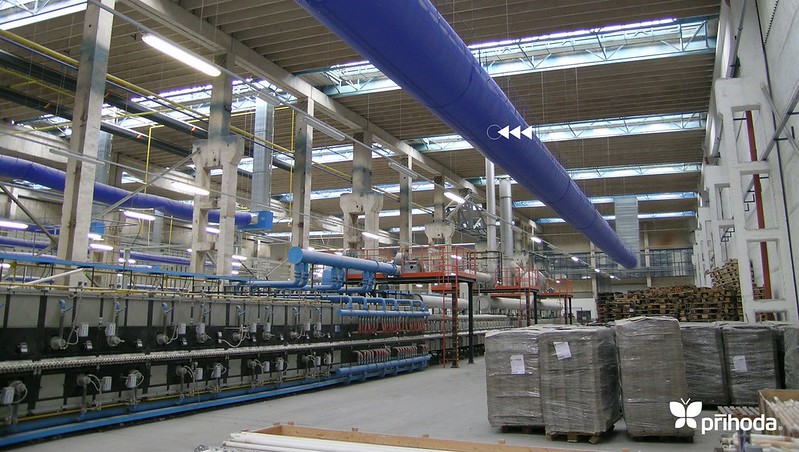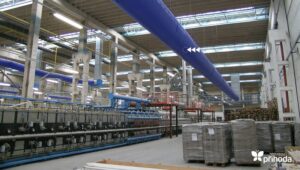

While metal ducts remained a conventionally proven choice, the introduction of technology-integrated, higher-efficiency fabric ducts holds astonishing capabilities. Let’s explore the two to find out which is better.
Comparing Fabric Duct With Metal Duct
The ducts are a critical part of heating, ventilation, and cooling in HVAC systems. The accuracy in the choice between the two types is significant to ensure higher operational efficiency while lowering the installation and maintenance cost.
With one being a proven method automatically winning the reliability, the technologically driven options are intriguing due to interesting and gifted characteristics.
Let’s consider the multitude of perks by comparing the characteristics of both types of ducts:
| Comparison | Fabric Ducts | Metal Ducts |
| Weight & Installation | Lightweight, easier, and faster to install | Heavier, more complex installation |
| Air Distribution | Even distribution, customizable airflow patterns | Standard airflow patterns |
| Durability | Less durable, susceptible to wear | More durable, longer lifespan |
| Environment Suitability | Better for controlled environments | Suitable for a wide range of environments |
| Corrosion Resistance | Does not corrode | Can corrode unless treated |
| Noise | Generally quieter | Can be noisier due to air turbulence |
| Maintenance | Need to be de-installed for maintenance works | Easier to dismantable and washable in industrial |
| Cost | Less expensive | More expensive |
| Aesthetics | Available in various colors, blends with interiors | Less aesthetic flexibility |
Air Distribution
While metal air ducts comprise different components, they lack the ability to manage the air velocity through the standard diffusers. The fabric air ducts find it as an important aspect and achieve the same through holes of varying diameter and area depending on the room size. The diffusers and holes combined achieve even distribution effects installation.
The heavy weight of metal ducts limits their installation. It contributes to additional load on the building and also requires a weight-bearing structure for its installation, along with the need to secure joints. Further, the surfaces needed to be designed accordingly for installation, and the requirement for additional bearings adds to the cost.
Contrastingly, the fabric duct is a lightweight option. It does not require pre-preparations for installation. Rather than requiring cables, they can be easily installed depending on the requirement and choice.
Air Drafts
The presence of air drafts is witnessed in the usage of a metal duct due to their rigidity and impermeability, which adds to the discomfort. Fabric ducts possess micro-perforation that eliminates the possibility of air draft.
Customization and Balancing
Available in a specific color, the customization of metal ducts is a task requiring additional contractors and site visits, which may or may not halt other operations. They also require balancing. The fabric ducts are automatically balanced on the system’s operation. They are already customized as per the requirements. They bring along multiple options in colors and patterns.
Maintenance
The metal ducts need to be de-installed for maintenance works. Moreover, the requirement for a specialist staff makes the maintenance costly and time-consuming. The fabric duct requires cleaning of the diffusers that are easily dismantable and washable in industrial or commercial machines.
Condensation
It is a well-known issue among metal ducts that leads to corrosion. The condensation occurs on the steel diffusers, making it unhygienic. Further, it also limits the usage in biological laboratories due to the chances of contamination. The fabric duct holds no such risk owing to its perforation capability.
Physical damage
The metal ducts are resistant to mechanical damage and fire resistance but may get deformed in the latter case. While fabric ducts are prone to physical damage, the technology can enhance their properties, making them resistant to higher temperatures reached during the fire.
Noise
The factor of noise generation and inability to suppress might pose a problem if you are considering metal ducts. It produces a specific sound, causing discomfort. There is no reason for fabric ducts to produce noise due to the lack of a metal body. Further, the noise produced due to diffusers is absorbed by the fabric itself due to its noise absorption characteristics.
Repair
Damage in any section requires de-installation and reinstallation. The repair depends on the intensity and type of damage. Considering fabric ducts, the possible damage is the tearing of the fabric. Sewing it up is an easy, cost-effective solution.
Exceptional Potential of Fabric Duct
The fabric ducts outperform the metal ducts in almost all of the comparison parameters listed above.
Structural integrity:
Being in use for longer times, the longer lifespans of metal ducts are generally a deal breaker. However, with the lack of any damaging or breaking force in the vicinity of fabric ducts in the industries, the fabric ducts outweigh this parameter, too. In scenarios of damaging possibilities, the customized material solutions available in fabric ducts offer the solution to the issue.
Longevity:
The longer lifespan of fabric ducts is constantly witnessed in a large number of industries. Further, the absence of damage with easier maintenance adds to the cost, customization adds to the aesthetics, and exceptional performance adds to the work efficiency.
Applicability:
Besides, the customization and designing of the installation procedure according to the location expands the suitability of fabric ducts to a wide number of locations. It finds applicability in Airport Terminal, Athletic Facilities, Data Centers, Fitness Centers, Grow Facilities, Fruit Packing Plant, Manufacturing, Laboratories, and many other industries.
Get an Efficient Fabric Duct System with Prihoda
With a clear choice in mind, the dilemma about the choice of fabric duct provider might still persist. Beginning with the qualities expected in the provider, experience, innovation, and technology are the foremost and non negotiable aspects expected from the provider. At Prihoda, having provided customized solutions to indoor agricultural facilities, universities, offices, recording studios, and much more, we have witnessed and successfully carried out projects at various locations.
Not only do we excel in customization, but we are also dedicated to sustainability, embracing environmentally friendly practices such as 100% post-consumer recycling. Having been established in the 90s, our quality of work has been unmatchable. Witness our extraordinary quality of product and service at your next industrial setup now!
See related: fabric ducts vs Metal Duct.
Common Questions About Fabric Duct vs Metal Duct
Q1. Which types of professionals are involved in fabric duct designing and customization?
- The engineers are concerned with airflow and indoor air quality customized to space, area, and shape of setup. The architects help you get the desired aesthetic, while contractors and facility maintenance will handle everything from designing to installation.
Q2. How do fabric ducts promise fire resistance and good air quality?
- The companies certify their claims of stated properties through certifications complying with international standards. Prihoda promises flame retardancy to the highest European and US standards and promises cleanroom compatibility based on ISO4 certification.
Q3. What are the benefits of fabric ducting?
- The fabric ducts are available at lower costs, inclusive of installation, maintenance, and installation. The air distribution is better and is not associated with noise disturbance. The added benefit is customization according to the aesthetics of the location, making them suitable for all types of industries.
Q4. Are there options in fabric materials?
- Yes, the fabric ducts can be customized based on the fabric material. For instance, Prihoda offers different options, such as:
- Prihoda light: non-permeable
- Prihoda light: permeable
- Prihoda recycled permeable
- Prihoda classic: permeable
- Prihoda premium: non-permeable
- Specialty materials
Q5. Why should I not choose metal ducts?
- Metal ducts promise a long shelf-life. However, with no scenario or conditions leading to structural damage, they add to the owner’s expenses. Not only is their installation time and cost-consuming, but their maintenance is also costly as well. The corrosion and microbial growth lead to contamination, making them unsuitable for various locations. The noise generation and inability to suppress further makes them an inconsiderable option.
Q6. What is the lifetime of fabric ducts?
- Though the lifetime depends on the choice of materials and other prospects, the warranty available on these ducts is around 10 years. Based on Prihoda’s almost 30 years of experience in the industry, the ducts tend to last fifteen years or longer, making them a long-term solution.
Q7. Are fabric ducts energy efficient?
- Yes, fabric ducts offer energy efficiency by contributing to effective air dispersion. It also reduces the pressure drops and hence optimizes the overall system efficiency.
Q8. How do fabric ducts reduce cost consumption compared to metal ducts?
- The material costs, easy installation and maintenance due to lightweight, and non-requirement of trained staff for simpler handling operations contribute to their lower costs compared to metal ducts.
 English
English Français
Français